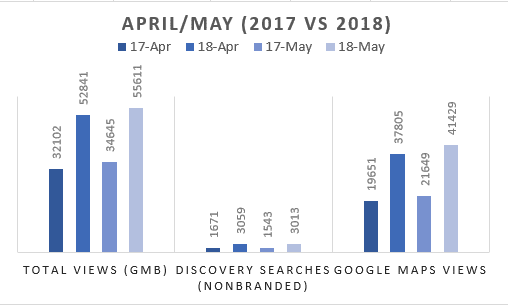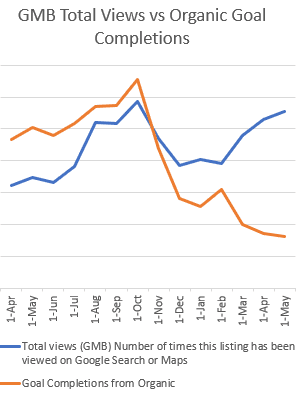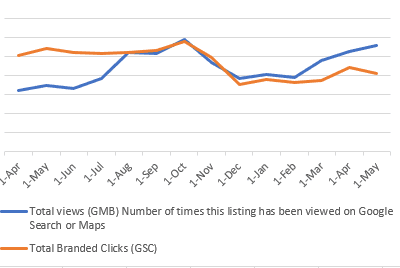Major unexplained drops in organic conversions are the stuff that SEO nightmares are made of. Everyone in the industry knows the feeling: you’ve done everything right, but the metrics keep dropping. Then the detective work begins – is it a manual penalty? Broken UX? Has your competition stepped up their game?
The search industry cranks out endless checklists for diagnosing drops in traffic, rank, and conversions, but it’s time to add a new threat to your list of potential culprits: your own Google My Business profile.
Diagnosing the Drop: A GMB Case Study
The problem that inspired this article first popped up back in October 2017. One of our clients started to see a slow leak in goal completions (in this case, phone calls and searches for directions to the business) driven by organic traffic. Even accounting for seasonality and site changes, conversions were dropping. Organic traffic itself didn’t seem to be the problem. We were seeing slight year-over-year drops in Sessions, but nothing that would account for the slide in goal completions.
As you can imagine, this made reporting tenser than we would’ve liked.
We went through the usual checklists, implemented a range of potential fixes, and were rewarded with a continuing slump in conversions. It was only after we started fully optimizing Google My Business that we began to wonder if it might be responsible for gobbling up goal completions.

Some minor year-over-year decreases in organic sessions, compared to…
…this. A free-falling organic goal completion count.
How to Download Google My Business Data
One of the biggest complications in catching Google My Business in the act of eating traffic is the difficulty in obtaining a large dataset of traffic and engagement metrics from the platform. Most GMB users are familiar with the Insights tab and its colorful charts, but it’s hardly a robust analytics tool. While it has plenty of handy data, it only allows users to view a week, month, or quarter’s worth of data, making it impossible to spot slow-moving trends.
To get a more complete idea of what’s going on, it’s instead necessary to dig a few levels deeper. This guide lays out the steps you’ll need to follow. If you’re on the new GMB agency dashboard, it’s much easier – you just need to navigate to the “Manage locations” tab, check desired locations, then click “Insights” in the “Actions” dropdown menu. Once you’ve managed to find that download link, it’s up to you to enter them into Excel and set up your own trend lines. This can be tedious, but it’s extremely worth it. Once we pulled and formatted all the data we could, we were able to start really digging in and spotting trends.
Our Findings: The Rising Influence of Google Maps
When comparing Year over Year data for April and May 2018, organic goal completions had suffered a -175% and -211% drop respectively. Those of you familiar with Google My Business Insights can probably guess that we expected to see those completions shift to GMB’s Total Actions metrics. To our surprise, this wasn’t the case. Total actions were up 7% in April, but dropped 6% in May.
However, while examining the data, we saw some other metrics that had much more dramatic shifts:

- Total views of the GMB profile were way up, climbing 65% year over year in April, 61% in May.
- Views from Discovery Searches (nonbranded) had similarly jumped 83% in April, 95% in May.
- Views of the profile in Google Maps had skyrocketed, climbing 92% in April, 91% in May.

Boom. Correlation. But why was this happening? Was there a reason for this extreme dovetail?
To follow our logic here, you’re going to need a bit of context on the client we were investigating. They’re not what you might think of as a standard SEO project. Instead of an ecommerce or content site, they’re a physical space and a tourist attraction. By far their most numerous goal completion was people searching for directions on the site – an action that is completely replaced by a simple search on Google Maps.
With this information, the picture becomes clearer. The growing visibility of their GMB profile on Google Maps was slashing the rate of goal completions on their website. Not only that, but since users didn’t even need to interact with their profile to get that information, we weren’t seeing a corresponding spike in GMB actions.
What Else Can GMB Have an Impact On?
We could have stopped here. We had a strong explanation for those worrying numbers. Not only that, we had compelling evidence that organic visibility and engagement was actually on the rise in a big way. Those increasing percentages in views represented tens of thousands of impressions, and interactions on the GMB profile were consistently falling between 3K-7K every month. Even at peak, their site had only driven hundreds of monthly goal completions. Google may have been slurping up their traffic, but their organic reach had never been higher.
But there was still something bothering us:

While it wasn’t as dramatic as the above charts, we were still seeing an interesting trend in the relationship between GMB views and branded clicks to the website (measured via Search Console). The two channels had entered our client’s offseason with branded clicks outpacing GMB views. They were roughly equivalent for a few months, then diverged again – but they’d swapped in terms of prevalence. GMB views were now much more numerous, and the trend appeared to be accelerating.
Things didn’t really click until our team lead dug up Rand Fishkin’s article on the growing rate of non-click interactions. This trend doesn’t specifically mention Google My Business, but a growing number of SEO professionals have been expressing alarm at the degree to which Google now dominates SERPs (Wesley Young just wrote a good one on how local search in has changed). Featured snippets in particular have been pointed out as an organic traffic siphon, and what’s GMB if not a featured snippet for branded search?
The question became: if our client’s GMB profile could address one major search intent, what else was it potentially answering? We’d been hard at work expanding and optimizing the profile without really asking ourselves what it was becoming. Upon review, we found that searchers could do all of the following without the fuss of clicking through to the website:
- See their address and get directions
- Make a phone call
- Read a quick blurb from Wikipedia (and click through to a trusted 3rd party informational resource!)
- View photos of the grounds
- See and interact with their phone number (phone calls were the one type of GMB action that did see major year-over-year increases)
- Ask and answer FAQs
- Write and read reviews
- See company hours and check for particularly busy times of the day
- See a short, branded summary of the company
- View and sign up for upcoming events, one of the client’s biggest KPIs
- See small factoids, like the fact that the company is woman-led, kid-friendly, wheelchair accessible etc.
Looking at that list, we can see clear replacements for a company’s ‘About Us’ page, their event pages, their FAQ page, their Contact page, their photo galleries, their testimonials…honestly, it’s amazing we haven’t seen a bigger leak of branded page clicks.
We still need to investigate this trend further, and I’m looking forward to pulling in year-over-year data during the coming months for the sake of improved visibility. We’ll also be checking out click through rates on brand pages and other potential canary-in-a-coalmine metrics, so stay tuned.
What Does GMB Mean for the Future of SEO?
Digging into the data did more than satisfy some basic curiosity about traffic trends – it completely redefined our relationship with the client. Before undertaking this research, we had spent months explaining to a patient, but likely disappointed team that we were still seeing declining returns from SEO. Now, we can actively track and optimize a channel that is becoming far and away their highest driver of traffic and conversions.
Given the current state of SEO, this is gigantic. The trends covered here are not about to slow down. Quite the opposite: Google has clearly indicated, over and over again, how committed they are to enhancing the visibility of Google Maps and Google My Business. Consider that the ability to add ‘Call Now buttons’ to posts has just been added, or the coming rollout of enhanced insights that also indicate an increasingly sophisticated attribute-based search system.
Compounding this issue is that smart SEOs are rigorous first adopters. We will be the first to take advantage of these new features, which is great, but we might also be tanking some of our own precious metrics when we do.
Here is the big takeaway: SEO isn’t going away, but it’s changing. You don’t need to like the direction the industry is taking, but if you want to stay in it, you’ll need to maintain visibility into what you’re accomplishing with your own efforts.
Want more insights into how Google’s evolving formats can be harnessed to reach your business goals? Get in touch. We’d love to discuss what our digital marketing experts can do for you.
Co-Authored by Alec Cole & Ashna Rana







